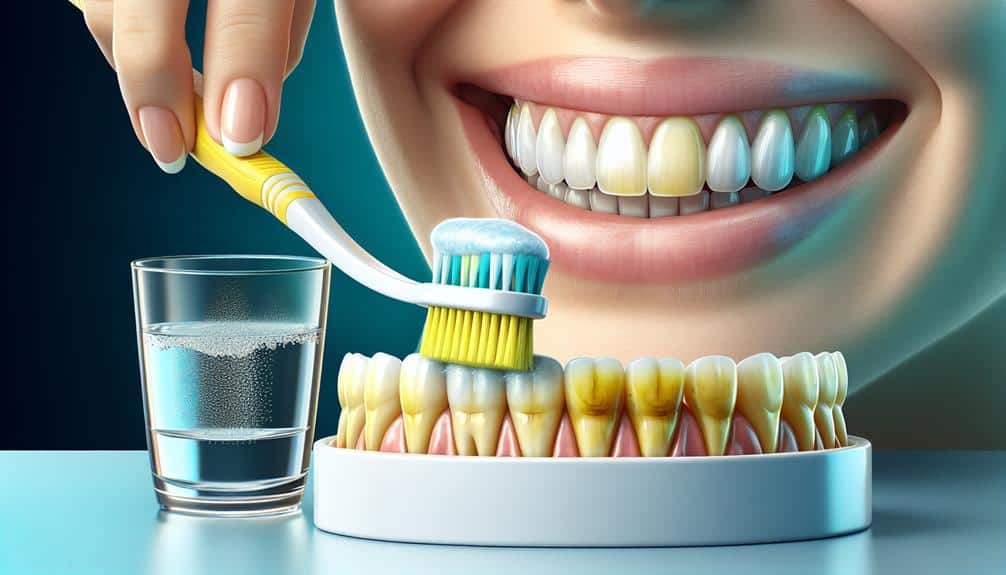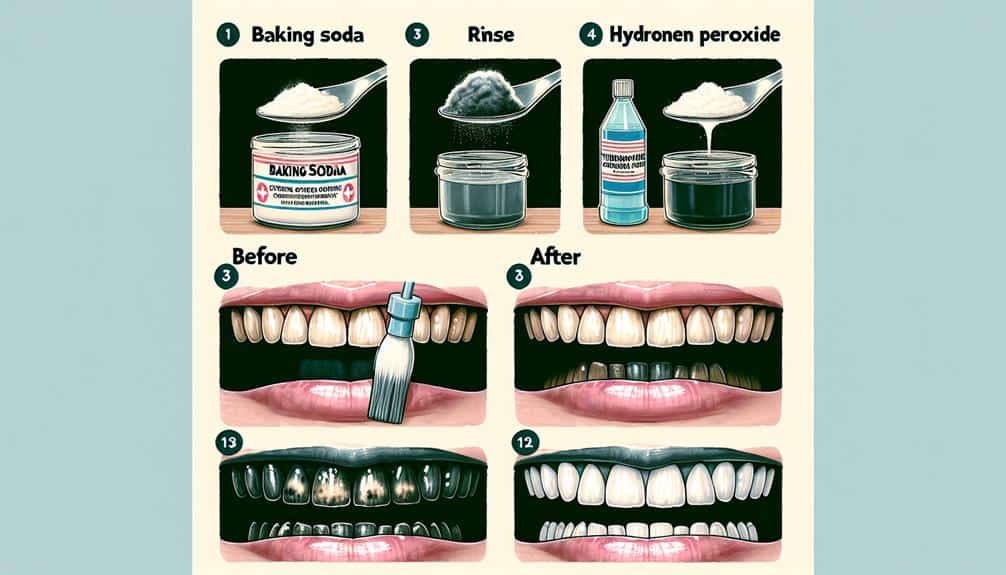To whiten tetracycline-stained teeth effectively, choose products targeting deep stains with high whitening agents. Consult a professional before starting treatment to prevent damage and guarantee success. Consistent routines with specific daily treatment times aid deep-seated stain removal. Monitor progress by regularly comparing photos to adjust treatments accordingly. Maintain results by watching your diet, avoiding teeth-staining items, and practicing good oral hygiene. Following these proven tips will lead to a brighter smile you'll love.
Key Points
- Use whitening products with high concentrations of whitening agents like hydrogen peroxide.
- Maintain a consistent whitening routine to target deep-seated tetracycline stains effectively.
- Monitor progress by taking regular photos of teeth to gauge improvements.
- Consider cosmetic dentistry options like veneers or bonding for severe tetracycline stains.
- Maintain results by avoiding teeth-staining foods, beverages, and tobacco products.
Understanding Tetracycline Stains
If you're curious about the root of your dental discoloration, understanding tetracycline stains can provide valuable insights into your situation. Tetracycline stains are a type of intrinsic discoloration that occur when the antibiotic tetracycline is taken during tooth development, leading to a gray or brownish hue. This discoloration happens because tetracycline becomes incorporated into the mineral structure of teeth, affecting their color. The causes of tetracycline stains are mainly linked to the use of tetracycline antibiotics during childhood when teeth are still developing.
When it comes to treatment options for tetracycline stains, traditional whitening methods like over-the-counter whitening toothpaste or professional dental cleanings may not be effective. In more severe cases, cosmetic dentistry procedures such as veneers, bonding, or crowns might be recommended to cover the discolored teeth effectively. Consulting with a dentist to determine the best course of action for your specific situation and achieve the desired results is crucial.
Choosing the Right Whitening Products
To effectively tackle tetracycline stains, selecting the appropriate whitening products is essential for achieving noticeable results in improving the discoloration of your teeth. When choosing whitening products, consider their effectiveness in targeting deep-set stains caused by tetracycline. Look for products specifically formulated to address stubborn discoloration, such as those containing higher concentrations of whitening agents like hydrogen peroxide or carbamide peroxide.
Before starting any whitening treatment, it's advisable to seek professional consultation from a dentist or dental hygienist. They can provide valuable insights into the most suitable whitening products based on the severity of your tetracycline stains and the overall health of your teeth. Professional guidance can help prevent potential damage to your enamel and gums while ensuring excellent results from the whitening treatment.
Consistency in Whitening Routine
Maintaining a consistent whitening routine is key to effectively addressing tetracycline stains on your teeth and achieving lasting results in improving their discoloration. Consistency benefits your whitening efforts by ensuring that the whitening products have sufficient time to work on the deep-seated stains caused by tetracycline. To establish successful routine habits, consider setting specific times each day for whitening treatments. This will help integrate the whitening process seamlessly into your daily schedule, making it easier to adhere to over the long term.
Furthermore, consistency in your whitening routine involves following the instructions provided with the whitening products diligently. Whether using whitening strips, trays, or gels, make sure to apply them as directed and for the recommended duration. Skipping treatments or using the products sporadically can hinder the whitening process and delay the desired results.
Monitoring Progress and Adjusting
When tracking your progress in whitening tetracycline-stained teeth, adjust your routine based on the changes you observe in the discoloration. Monitoring results is essential to determine the effectiveness of the treatment. Take regular photos of your teeth under consistent lighting conditions to accurately track changes. Compare these photos over time to gauge improvements and decide if adjustments are necessary.
If you notice minimal progress after a few weeks, consider increasing the frequency of your whitening sessions or switching to a stronger whitening product. On the other hand, if you experience tooth sensitivity or gum irritation, reduce the frequency or duration of treatments to prevent further discomfort.
Always follow the instructions provided with your whitening product and consult with your dentist if you have any concerns. By actively tracking your results and adjusting your treatment accordingly, you can optimize the whitening process and achieve the desired outcome efficiently. Remember, patience and consistency are key when whitening tetracycline-stained teeth.
Maintaining Results for Longevity
Given the efforts you've put into monitoring your progress and adjusting your routine, the next step is to guarantee that you maintain the results achieved for long-term whitening success. Consistency in your diet and lifestyle habits plays an important role in preserving the effects of tetracycline teeth whitening.
Your diet can have a significant impact on the longevity of your whitening results. Foods and beverages that stain teeth, such as coffee, tea, red wine, and berries, can diminish the effects of whitening treatments over time. To maintain your bright smile, consider limiting consumption of these items and incorporating more teeth-friendly options like crunchy fruits and vegetables that naturally help clean teeth.
Furthermore, your lifestyle habits can either support or detract from your whitening efforts. Avoiding tobacco products, which can cause yellowing of teeth, and practicing good oral hygiene, including regular brushing and flossing, are essential for prolonging the effects of tetracycline teeth whitening. By being mindful of your diet impact and lifestyle choices, you can assure that your newly whitened smile remains radiant for the long haul.
Frequently Asked Questions
Can Tetracycline Teeth Whitening Be Effective for All Levels of Tetracycline Staining, or Are There Certain Cases Where It May Not Work as Well?
Tetracycline teeth whitening can vary in effectiveness based on stain severity. While it may work well for some cases, success rates can be lower for severe staining. Consult a dental professional to determine the best approach for your specific situation.
Are There Any Potential Side Effects or Risks Associated With Using Tetracycline Teeth Whitening Products?
When using tetracycline teeth whitening products, there are potential risks to ponder. It's important to weigh the benefits against potential long-term effects. Success rates vary, and consulting with a dental professional is key.
How Long Does It Typically Take to See Noticeable Results When Using Tetracycline Teeth Whitening Products?
Typically, using tetracycline teeth whitening products can show noticeable results within a few weeks. The treatment duration varies, but a visible improvement in teeth color is expected as the product effectiveness increases throughout the process.
Can Tetracycline Teeth Whitening Be Combined With Other Dental Treatments, Such as Professional Teeth Whitening or Veneers?
Combining tetracycline teeth whitening with other dental treatments like professional whitening or veneers can offer enhanced results. These combination treatments provide alternative options for achieving a brighter smile and addressing specific dental needs effectively.
Are There Any Specific Dietary or Lifestyle Changes That Should Be Made in Conjunction With Tetracycline Teeth Whitening to Enhance Results?
To enhance results with tetracycline teeth whitening, consider dietary restrictions like avoiding staining foods and drinks. Lifestyle changes such as quitting smoking can help. Home remedies like oil pulling may complement professional advice for best outcomes.



